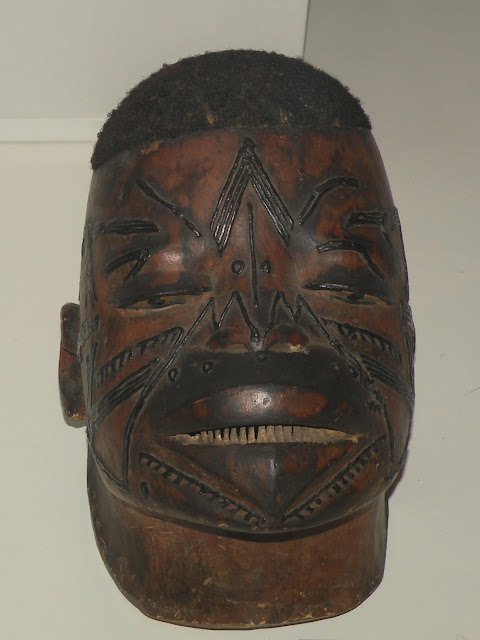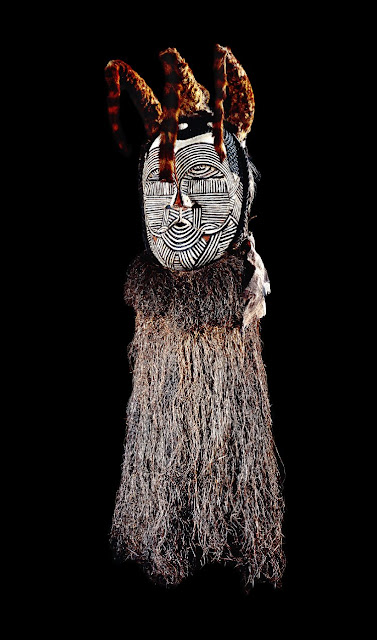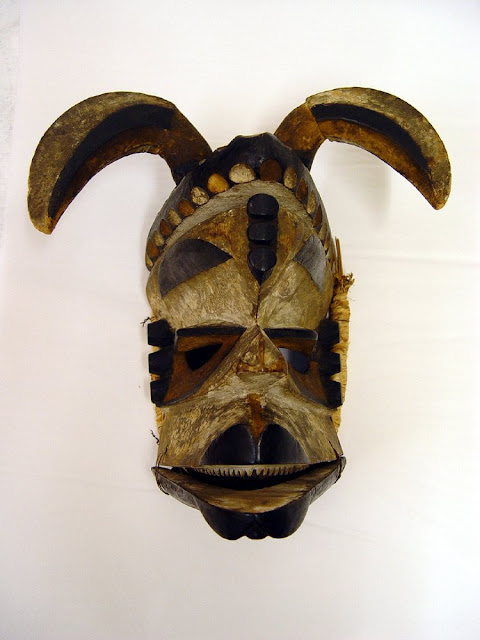Bangende mask. Cotton, cowrie shell, beads, raffia, wood
Democratic Republic of Congo. From the collection of the Horniman Museum
Democratic Republic of Congo. From the collection of the Horniman Museum
The only time I had a chance to have a closer look at African masks was during my visits to the British and Horniman Museums in London. The masks definitely left a strong impression on me...some looked really scary, some were beautiful in their own unique way and others struck with skillfulness and complexity of handicraft work. African masks are not something you can easily forget once you have seen them. Sometimes masks are a realistic representation of the human or animal head but more often they are carved in an exaggerated or distorted way designed to suggest a supernatural presence.
There is no way to know when masking began in Africa but the presence of masks in rock paintings suggests that it is likely a very ancient tradition. There are many tens of thousands of masks in existance today, both in Africa and in collections worldwide. They differ from one another in so many different ways: they can represent human, animal or spirit as well as male or female; they can be gigantic or very small; be made of wood, metal or ivory. Some masks are meant to be used in public performances and private rituals such as coming of age ceremonies, funerals, harvest celebrations while the purpose of others is to be used as charms or amulets to cure illness or to offer protection during work or travel.
Wooden mask in the form of an elongated face, with incised decoration covering the surface. Songye, Democratic Republic of Congo. From the collection of the Horniman Museum
There is no way to know when masking began in Africa but the presence of masks in rock paintings suggests that it is likely a very ancient tradition. There are many tens of thousands of masks in existance today, both in Africa and in collections worldwide. They differ from one another in so many different ways: they can represent human, animal or spirit as well as male or female; they can be gigantic or very small; be made of wood, metal or ivory. Some masks are meant to be used in public performances and private rituals such as coming of age ceremonies, funerals, harvest celebrations while the purpose of others is to be used as charms or amulets to cure illness or to offer protection during work or travel.
Man's head mask made of wood, hair (human), wax. Made by Makonde, Mozambique. The British Museum
Masquerade mask made of fibre and abrus seeds. Nigeria, Plateau, Jos. The British Museum
Circumcision mask (with plaits) made of wood, fibre (raffia), cloth (raffia). Pende people, Democratic Republic of Congo. The British Museum
Face-shaped mask made of wood, fur, skin (monkey, +fur), raffia, with a fibre fringe or 'beard' and three fur horns. Tetela people, Democratic Republic of Congo. The British Museum
The shape of a mask is traditional and not subject to the stylistic taste of its maker. African masks can be designed to cover the head, just the face or be used as a headdress that is attached to the top of the head.
Gelede mask made of coloured wood in the form of a head with figures on top. Yoruba people, Nigeria, 19th century. The British Museum
Wood and fibre dance mask, carved with an articulated jaw. Ibibio people, Nigeria. The British Museum
References:
Encyclopedia of World Dress and Fashion, Volume 1: Africa.
African Hats and Jewelry by Duncan Clarke
Craft Traditions of the World by Bryan and Polly Sentance
The Art of African Masks. Exploring Cultural Traditions by Carol Finley











Interesting article!!! Thanks for sharing !!!! What skills ...to be able to make such complicated masks!!! Some of them look kind of scary!!!!
ReplyDelete